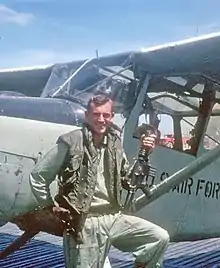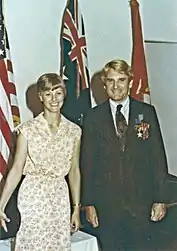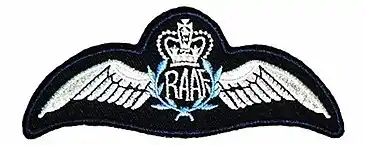Garry Cooper | |
|---|---|
 Cooper in Vietnam in 1968 | |
| Born | 21 January 1938 Adelaide, South Australia |
| Allegiance | Australia |
| Service/ | Royal Australian Air Force |
| Years of service | 1960–1969 |
| Rank | Flight Lieutenant |
| Battles/wars | Indonesia–Malaysia confrontation Vietnam War |
| Awards | Distinguished Flying Cross Air Force Cross (United States) Silver Star (United States) Distinguished Flying Cross (United States) Cross of Gallantry (South Vietnam) |
| Spouse(s) | Jean Cooper |
| Other work | Airline Captain (1969–2000) |
Garry Gordon Cooper, DFC (born 21 January 1938) is a retired airline captain and a former fighter pilot in the Royal Australian Air Force (RAAF) who attained the rank of flight lieutenant. Cooper served on assignment with the United States Air Force (USAF) as a Forward Air Controller (FAC) in South Vietnam. Whilst working as a FAC in 1968, he was assigned to support the United States Army's 9th Infantry Division. For his actions in Vietnam, Cooper was awarded the Distinguished Flying Cross and the United States' Air Force Cross for heroism.[1][2]
Early life
Garry Cooper was born on 21 January 1938 in Adelaide, South Australia. His basic education was at various primary schools around Adelaide and he matriculated from the School of Mines and Industries. Postgraduate, he completed a Diploma in Aeronautical Engineering. Cooper gained his Silver "C" glider pilot's licence at the age of sixteen before taking up powered flying. At the age of nineteen, Cooper gained his commercial pilot licence and obtained employment with the Flying Doctor Service in Central Australia. He subsequently gained employment with Gibbes Sepik Airways in New Guinea where he flew the Norseman UC-64A, Junkers JU52, de Havilland DH84 and various Cessna aircraft. After flying in New Guinea for three years, Cooper was selected to start pilot training with the Royal Australian Air Force (RAAF).[3]
Royal Australian Air Force pilot
Cooper joined the Royal Australian Air Force (RAAF) on 11 March 1960 to commence pilot training on No. 39 Pilots' Course with twenty other trainee pilots.[4] Only eleven passed the course. Upon graduation, he received the Most Proficient Pilot award.[5][6] After graduation and gaining his wings, Cooper was first posted to the School of Air Navigation flying the Dakota C-47, Canberra, Vampire and Winjeel aircraft. This tour was interrupted with two tours to Antarctica flying the Beaver DHC-2 on floats and skis from the Danish ship Thala Dan.[7][8]
In 1962 Cooper was posted to fly the Commonwealth Aircraft Corporation (CAC) Avon Sabre fighter aircraft, the Australian variant of the North American F-86 Sabre. Cooper served operational tours on the Sabre in Thailand, Borneo and Malaysia. During one mission, operating out of RAAF Butterworth, Malaysia on 10 April 1964, Cooper experienced an engine fire indication in his single-engine Sabre. After shutting the engine down and being too far away to glide back to the airfield at Butterworth, he conducted a safe 'glide landing' at Bayan Lapas on the island of Penang. On 3 January 1966, Cooper commenced his Mirage IIIO fighter conversion course on No. 5 Mirage Course at No. 2 Operational Conversion Unit (2OCU).[9] The Mirage had only commenced service in the RAAF in October 1964 and was the first Australian fighter jet capable of flying at speeds over Mach 2. On 30 May 1966, approximately one minute after takeoff from RAAF Base Williamtown, Cooper experienced a total engine failure in his Mirage whilst climbing through only 1,500 feet (460 m) at 380 knots. Cooper was unable to restart the engine. Being a single-engine fighter jet, Cooper flew the Mirage like a glider and landed on an abandoned war-time airstrip at Tomago (Hexam), New South Wales, without damaging the aircraft.[10][11][12] The Mirage was towed back to RAAF Base Williamtown via the local roads which took 14 hours.[13] Subsequent investigations revealed that the Mirage had ingested a large bird that had lodged against the face of the compressor blocking airflow into the engine.[14]
Wing Commander Jim Flemming, Commanding Officer of No. 75 Squadron, was leading the formation of four Mirages when Cooper experienced his engine failure. Flemming provided Cooper with a Flying Log Book endorsement, approved by the Air Officer Commanding Operational Command, which read:
Flight Lieutenant Garry COOPER displayed a very high degree of professionalism throughout a difficult and dangerous situation and the manner in which he followed correct drills and procedures for the forced landing was exemplary. That he could assess and take advantage of so critical a situation in the time available and then bring the heavily loaded aircraft to a stop in such a short distance reflects credit on himself, his training and the RAAF." In 1999, Air Vice Marshall Flemming (retired) would add, "That Flt Lt Cooper landed his aircraft, without damage, on a short dis-used wartime strip was little short of incredible.
Cooper participated in some developmental testing for the Mirage III, where he evaluated flying with full pressure (space) suits. These pressure suits would enable the pilots to fly the Mirage up to altitudes over 75,000 feet (23,000 m) for conducting high altitude intercept missions – well above the normal maximum operating altitude of 50,000 feet (15,000 m).[15][16]
Vietnam War – Forward Air Controller
Cooper was posted to South Vietnam to serve as a Forward Air Controller (FAC)[17][18] with the United States Air Force (USAF) from March to November 1968.[19][20][21] Although he was an Australian fighter pilot, he served within a USAF unit, the 19th Tactical Air Support Squadron (TASS), a unit of the 504th Tactical Air Support Group, Seventh Air Force. In this FAC role, where the overall mission is to support the Army, Cooper was assigned to support the 3rd Brigade, 9th Infantry Division, US Army under the command of Major General Julian Ewell. During his tour in South Vietnam, Cooper completed 620 hours of combat flying in 323 combat missions. Between 1967 and 1971, 36 RAAF fighter pilots served as FAC pilots in Vietnam with the USAF.
Upon arrival in South Vietnam, he was assigned the callsign 'Tamale 35'[22] and would perform his FAC duties in the O-1 Bird Dog. Initially based in Tân An, 40 km southwest of Saigon, due to increased security risks he would later be relocated to Đồng Tâm Base Camp, 67 km southwest of Saigon on the Mekong River.
After his FAC training, Cooper was required to perform his missions during the height of the Vietnam War which saw some of the most intense operational periods, notably the May Offensive or Mini-Tet of 1968. During the period 9–11 May, Cooper was flying around-the-clock missions at any time of day, typically for 3 to 4 hours in duration. On 11 May, Cooper had been awake for 19 1/2 hours, during which time he had been flying for 13 hours of which five of those hours were spent evading anti-aircraft fire during his missions.[23]
In late October 1968, Cooper was assigned as a FAC Combat Instructor on the OV-10 Bronco prior to repatriating to Australia in November.
Military awards

Cooper is the most highly decorated RAAF pilot to have served in the Vietnam War.

During his combat tour, Cooper's highest award was the USAF Air Force Cross which he received twice.[24][25] The Air Force Cross is the second-highest USAF award after the Medal of Honor. Since the inception of the US Air Force Cross in 1960, only ~200 have been awarded. Cooper is the only non-US citizen to have been presented this award for his extraordinary heroism. Whilst awarded in 1981, Cooper had a special contemporary commemoration ceremony of this achievement at the Evans Head Returned and Services League (RSL) in New South Wales, Australia on 4 December 2021.[26]
Cooper's second USAF Air Force Cross award citation reads:
... for extraordinary heroism in military operations against an opposing armed force as a Forward Air Controller attached as an Air Liaison Officer to the 3rd Brigade, 9th Infantry Division, (US Army), on 18 August 1968 in the Republic of Vietnam. On that date, after being shot down in an OH-23 observation helicopter, Flight Lieutenant Cooper rescued a badly wounded Brigade Commander from the wreckage under extremely heavy automatic weapons fire. Although wounded himself, but with complete disregard of his own safety, he carried the Colonel to a protected area where he fought off several attempts to over-run them killing ten enemy soldiers at close range. During the helicopter rescue next day, he killed a further two enemy with his empty AR-15. Flight Lieutenant Cooper was solely responsible with the saving of Colonel Archer under over-whelming odds. Through his extraordinary heroism, superb airmanship and aggressiveness in the face of the enemy, Flight Lieutenant Cooper reflected the highest credit upon himself and the United States Air Force.

Cooper is also one of only a few RAAF pilots to be awarded the Air Force Ground Combat Badge.[27]
Summary of awards:

_with_Mr_and_Mrs_Cooper.jpg.webp)
Foreign awards (United States)
- Air Force Cross (2) (the only non-US Citizen recipient and one of only 4 other multiple AFC recipients in history)
- Silver Star[28][29]
- Distinguished Flying Cross[30][31](3 with "V" for Valor device)
- Bronze Star Medal (2, including 1 with "V" device)
- Purple Heart[32] (2)
- Air Medal (15, including 2 with "V" device)
- Army Commendation Medal (2, including 1 with "V" device)
- Antarctica Service Medal
- US Presidential Unit Citation
- US Army Valorous Unit Award
- US Army Meritorious Unit Commendation
Foreign awards (Republic of Vietnam)
- Republic of Vietnam Campaign Medal[33]
- Republic of Vietnam Gallantry Cross (with Silver Star)
- Republic of Vietnam Gallantry Cross (with Palm)
- Republic of Vietnam Wound Medal
- Vietnam Armed Forces Honor Medal (1st Class)
- Republic of Vietnam Gallantry Cross (with Palm Unit Citation)
- Republic of Vietnam Civil Actions Medal Unit Citation (US Army)
Foreign awards (Malaysia)
Australian / British Imperial Awards
- Distinguished Flying Cross[35][36][37]
- Australian Active Service Medal (1945–1975) (Vietnam and Malaysia)
- General Service Medal (1962)[38] (Borneo and Malay Peninsula)
- Vietnam Medal
- Australian Service Medal (1945–1975) (Thailand and Thai-Malay)
- Australian Defence Medal
- Ground Combat Badge[39]


Author – 'Sock it to 'em Baby'
With co-author Robert Hillier, Garry Cooper wrote a book about his Vietnam experience in 1968. In 2006 the book was published under the title, Sock it to 'em Baby – Forward Air Controller in Vietnam.[40][41][42]
Airline career


After returning from Vietnam,[43] Cooper left the RAAF and took up employment as a co-pilot with Cathay Pacific Airways in Hong Kong, flying Convair 880 aircraft. Due to the rapid expansion of the airline, it took less than eighteen months for him to become a captain. With Cathay Pacific, Cooper advanced through the Boeing 707 and the Lockheed L1011 aircraft. After ten years in Hong Kong, Cooper then gained employment with Saudi Arabian Airlines as an L1011 Check Captain. Following two years in Jeddah, Saudi Arabia, he was offered employment with Kerry Packer, flying Packer's Learjet 35 around Australia on VIP operations carrying such dignitaries as Princess Diana and other world leaders. After several years, Cooper resumed flying as an international airline captain with Park Aviation, flying Boeing 707 and Boeing 747 aircraft. Park Aviation had crews and aircraft leased out to Lufthansa in Frankfurt, Caribbean Airlines in Paris, and Cargolux in Luxembourg. In 1980 Cooper received a letter of commendation from King Hussein of Jordan for landing a Boeing 707 on one engine after losing three engines on takeoff from Dhahran, saving 116 passengers and crew. In 1989 he landed a Boeing 747 at Martinique with 450 passengers and crew during Hurricane Hugo in wind speeds of 200 km/h. Cooper subsequently returned to Australia, gaining employment with Ansett Airlines flying Boeing 767 and Boeing 747 aircraft. As the post-traumatic stress disorder (PTSD) he had acquired from his Vietnam service became advanced, Cooper took retirement after accumulating over 25,000 hours of flying. In his retirement, Cooper continued flying various warbirds at airshows.[44] Cooper was once the owner of a replica Japanese Zero fighter,[45] which was based on a modified T-6 Harvard.[46] This was the same aircraft used in the 1970 war movie, Tora! Tora! Tora!, which dramatised the Japanese attack on Pearl Harbor in 1941. Cooper performed a simulated attack display in the 'Zero' during the 2005 Australian International Airshow[47] at the Avalon Airshow as part of the 60-year commemoration since the end of the Second World War.
References
- ↑ Wilson, Neil (April 2017). "Garry Cooper – Tamale 35". The Mini Bribie Islander Community Magazine. pp. 1, 3–5. Retrieved 22 February 2022.
- ↑ Department of Defense, United States (12 June 2022). "Military Awards For Valor". US Department of Defense – Military Awards for Valor – Description of Medals. Retrieved 12 June 2022.
- ↑ Buckley, Phil (14 January 2017). "Interview with Garry Cooper". Down Under Aviation News (DUAN). Retrieved 21 February 2022.
- ↑ "No. 39 Pilots Course Graduation Photo". Radschool Association Inc. 16 June 1961. Retrieved 21 February 2022.
- ↑ Cooper, Garry (1 July 1961). "Pearce Graduation – No.39 Pilots' Course". RAAF News. p. 6. Retrieved 22 February 2022.
- ↑ Cooper, Garry (7 September 1961). "Permanent Air Force – Commission Appointment". Commonwealth of Australia Gazette. p. 3292. Retrieved 21 February 2022.
- ↑ Antarctic Program, Australian. "Thala Dan Antarctic Expedition Ship". Retrieved 17 February 2022.
- ↑ "National Mapping's Surveying and Mapping Activities in Antarctica 1950s to 1990s". Division of National Mapping Australia. 1962–1963. Retrieved 21 February 2022.
- ↑ Susans, Martin (1990). The RAAF Mirage Story (PDF). RAAF Base Point Cook, VIC, Australia: Royal Australian Air Force Museum. p. 127. ISBN 0-642-14835-X.
- ↑ "A3-29 Dead Stick Landing – Garry Cooper". flickr.com. May 1966. Retrieved 21 February 2022.
- ↑ Cooper, Garry. "An Oscar for Garry Cooper". RAAF News. p. 3. Retrieved 21 February 2022.
- ↑ Wilson, Stewart (1989). The Meteor, Sabre & Mirage in Australian Service. Weston Creek, ACT, Australia: Australian Aerospace Publications. p. 184. ISBN 095879782X.
- ↑ "Mirage A3-29 RAAF Photo". ADF Gallery. May 1966. Retrieved 21 February 2022.
- ↑ "ADF Serials – Mirage III". www.adf-serials.com.au. Retrieved 2022-06-12.
- ↑ "Pressure Suit Tests". Aircraft Life Support Fitters. Retrieved 21 February 2022.
- ↑ "75 Squadron History – Pressure Suit Tests". Aircraft Life Support Fitters. Retrieved 21 February 2022.
- ↑ "Sock it to 'em Baby – RAAF Birdog FAC in Vietnam". Heritage Flight Gear Displays. 30 September 2011. Retrieved 21 February 2022.
- ↑ "Garry Gordon Cooper DFC". Virtual War Memorial Australia. Retrieved 22 February 2022.
- ↑ "Flight Lieutenant Garry Gordon Cooper". Australian War Memorial. Retrieved 21 February 2022.
- ↑ Atkins, Jonathan (24 April 2009). "Salute to the Anzacs". Australian Broadcasting Corporation. Retrieved 21 February 2022.
- ↑ Dowdell, David (2001). "Vietnam Reunion Australia 1967–1968". Vietnam Security Police Association Inc. Retrieved 21 February 2022.
- ↑ "RAAF FAC History". Forward Air Controllers Association. October 2001. Retrieved 21 February 2022.
- ↑ "Who the Hell are You? Garry Cooper". Queensland Returned and Services League News (Edition 06, 2013 (Website only archives editions back to 2017) ed.). 2013. pp. 66–70. Archived from the original on 2022-02-21.
- ↑ US Home of Heroes – Service Crosses. "US Service Crosses". Home of Heroes. Retrieved 18 February 2022.
- ↑ "Air Force Cross (United States)". wikipedia.org.
- ↑ "Major Award for Living Legend Garry Cooper". Evans Head Living Museum. 4 Dec 2021. Retrieved 21 February 2022.
- ↑ Defence, Australian Government (7 August 2013). "Air Force Ground Combat Badge". Australian Department of Defense – Honours and Awards. Retrieved 13 June 2022.
- ↑ Silver Star Awards – Vietnam War. "Silver Star awards – Vietnam War". Home of Heroes. Retrieved 18 February 2022.
- ↑ Project, The Hall of Valor. "Garry Cooper – Silver Star Award". Military Times – Valor. Retrieved 18 February 2022.
- ↑ National Air and Space Museum, Smithsonian. "Garry Cooper – Wall of Honor". Smithsonian – National Air and Space Museum. Retrieved 18 February 2022.
- ↑ Society, Distinguished Flying Cross. "Garry Cooper – DFC Honor Roll". DFC Society. Retrieved 18 February 2022.
- ↑ Cooper, Garry. "FLTLT Garry Cooper – Purple Heart Hall of Honor". National Purple Heard Hall of Honor. Retrieved 17 Feb 2022.
- ↑ Honours and Awards, Defence. "Republic of Vietnam Campaign Medal". Defence Honours and Awards. Retrieved 18 February 2022.
- ↑ Honours and Awards, Defence. "Pingat Jasa Malaysia Medal". Defence Honours and Awards. Retrieved 18 February 2022.
- ↑ Cooper, Garry (April 1969). "RAAF News – RAAF Members Decorated". RAAF News. pp. 1–2. Retrieved 21 February 2022.
- ↑ "Distinguished Flying Cross Awards". Commonwealth of Australia Gazette – Issue 23. 13 March 1969. p. 1547. Retrieved 21 February 2022.
- ↑ "The London Gazette No. 44840 – Honours and Awards – Distinguished Flying Cross". The London Gazette. 2 May 1969. p. 4657. Retrieved 21 February 2022.
- ↑ Honours and Awards, Defence. "General Service Medal 1962". Defence Honours and Awards. Retrieved 18 February 2022.
- ↑ Honours and Awards, Defence. "RAAF Ground Combat Badge". Defence Honours and Awards. Retrieved 18 February 2022.
- ↑ Cooper, Garry (2006). Sock it to 'em Baby – Forward Air Controller in Vietnam. Crows Nest, NSW: Allen & Unwin. ISBN 9781741761351.
- ↑ Unwin, Allen & (18 February 2022). "Sock it to 'em Baby". Allen & Undwin Publishers.
- ↑ "ADF Serials Newsletter – Sock it to 'em Baby" (PDF). ADF Serials. May 2006. p. 4. Retrieved 21 February 2022.
- ↑ "Vietnam War Service – Veteran Details". Australian Government – Department of Veterans' Affairs. Retrieved 21 February 2022.
- ↑ Boyd, Halden (24 December 2020). "Evans Head Drive In Airshow a World First". The Northern Rivers Times – Issue 25/2020. p. 63. Retrieved 21 February 2022.
- ↑ "Mitsubishi Zero VH-ZRO Tora replica Down Under". Australian Flying. 17 April 2010. Retrieved 22 February 2022.
- ↑ "A6M2 TORA Zero". Heritage Flight Museum. Retrieved 22 February 2022.
- ↑ "2005 Avalon Airshow". Australian International Airshow. 2005. Retrieved 22 February 2022.